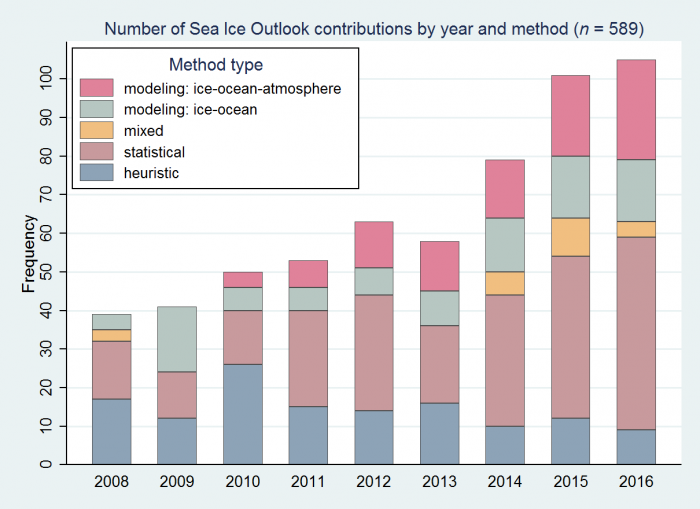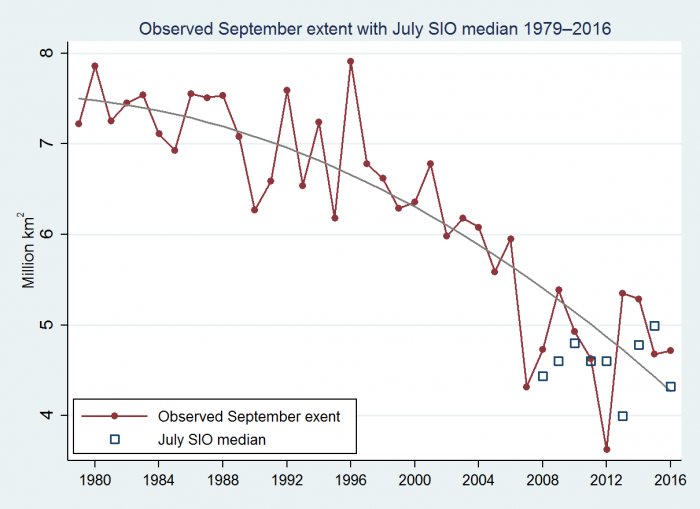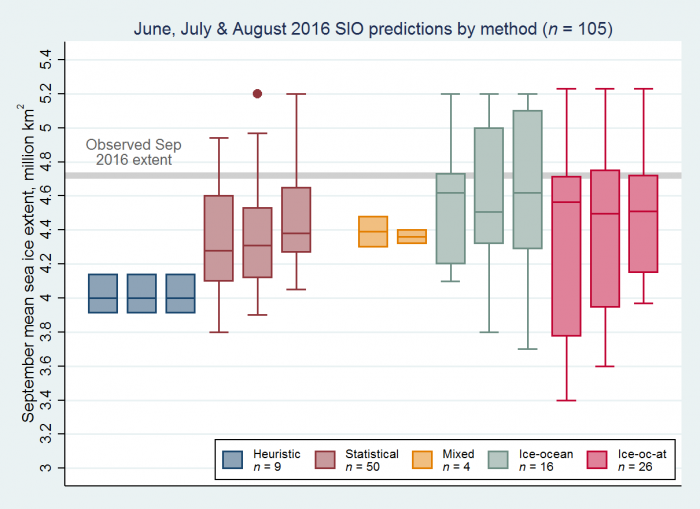By: Lawrence C. Hamilton, Carsey School of Public Policy, University of New Hampshire; and Julienne Stroeve, National Snow and Ice Data Center, University of Colorado
Summer sea ice cover on the Arctic Ocean has been declining since the 1970s, as the Arctic itself warmed. In 2007 the sea ice decline steepened abruptly to reach a new record low (Stroeve et al. 2008). Even scientists with their eyes on the Arctic were surprised by the sudden drop, which focused attention on the need for better prediction. Where was Arctic change heading, and how fast?
Responding to this need to improve prediction, the Study of Environmental Arctic Change (SEARCH) organized the Sea Ice Outlook (SIO), to which any group or individual could contribute their prediction of how many square kilometers (km2) of sea ice would remain in September. The initiative has been highly successful, drawing 39 contributions to its early June, July, and August cycles in 2008. The number rose steadily to reach 105 in 2016, with a total of 589 over the nine-year series. In 2014, the SIO was incorporated into a new project, the Sea Ice Prediction Network (SIPN).
Figure 1 charts this rise, distinguishing different types of methods such as statistical, modeling, or a catch-all group termed "heuristic." Among modeling efforts, we see increasing sophistication as more contributions employ coupled models that take into account the dynamics of ice, ocean, and atmosphere.

How accurate were the predictions? Several papers have analyzed their performance, comparing individual and median SIO predictions with the actual extent of sea ice each September from 2008 through 2013 (Stroeve et al. 2014) or through 2015 (Hamilton and Stroeve 2016). Figure 2 updates these comparisons through 2016. The graph shows median SIO contributions from July each year from 2008 to 2016, along with the 1979–2016 satellite era record of September sea ice extent and its downward trend.

Close inspection finds a pattern of "easy and difficult" prediction years, corresponding roughly to the difference between climate and weather (for a summary with additional data, see Hamilton and Stroeve 2014, Witness the Arctic, Spring 2014). Easy years are those when sea ice extent is close to its long-term downward trend, which reflects Arctic warming, and is illustrated by the smooth curve in Figure 1. In difficult-to-predict years, summer wind and weather push sea ice well above or below its climatological trend, and most SIO predictions are off the mark.
In summer of 2016 for example, the Arctic ice cover was very broken up, but weaker than usual compacting effects from wind or currents left it thinly spread out. Despite the lack of compaction, ice reached its second-lowest historical extent on 10 September, but the dispersed ice pack then refroze over a wide area as temperatures cooled later than month. The monthly average ended above most of the SIO predictions (see Figure 3).

Although the 2016 daily minimum tied with 2007 as the second lowest, freeze-up following that minimum was faster than seen in the last ten years (nearly 1 million km2 from 16 September through 1 October), leading to the monthly mean for September that was fifth lowest and above the long-term trend line. The median SIO prediction, on the other hand, was in line with the long-term trend (see Figure 2). Had the ice growth rate following the minimum been similar to that in 2007, the resulting September mean would have been close to the median SIO prediction.
Arctic sea ice is currently in a transitional state between a cooler past, when much thick multiyear ice survived through the summer, and a warmer future, when little of this thick ice remains. Thinner ice is sensitive to summer weather, such as how the winds blow and whether skies are sunny. Weather sensitivity makes ice extent hard to predict for any one year, although the longer-term trend is all too clear.
Acknowledgments
This research was carried out under the Sea Ice Prediction Network (SIPN) project, with support from the U.S. National Science Foundation (PLR-1303938) and the Office of Naval Research (N00014-13-1-0793). Helen Wiggins and Betsy Turner-Bogren (ARCUS) provided Sea Ice Outlook data.
References
Hamilton, L.C., C.M. Bitz, E. Blanchard-Wrigglesworth, M. Cutler, J. Kay, W. Meier, J.Stroeve & H. Wiggins. 2014. "Sea ice prediction has easy and difficult years." Witness the Arctic spring, pp. 3–7. Fairbanks, AK: Arctic Research Consortium of the U.S. http://www.arcus.org/witness-the-arctic/2014/2/article/21066
Hamilton, L.C. & J. Stroeve. 2016. "400 predictions: The SEARCH Sea Ice Outlook 2008–2015." Polar Geography doi: 10.1080/1088937X.2016.1234518
Stroeve, J., L.C. Hamilton, C.M. Bitz & E. Blanchard-Wrigglesworth. 2014. "Predicting September sea ice: Ensemble skill of the SEARCH Sea Ice Outlook." Geophysical Research Letters 41:2411–2418. doi: 10.1002/2014GL059388
Stroeve, J., M. Serreze, S. Drobot, S. Gearheard, M. Holland, J. Maslanik, W. Meier, and T. Scambos. 2008. "Arctic sea ice extent plummets in 2007." EOS Transactions 89(2):13–14.
